2011年模拟试题11
2011年工作分析与评价模拟题
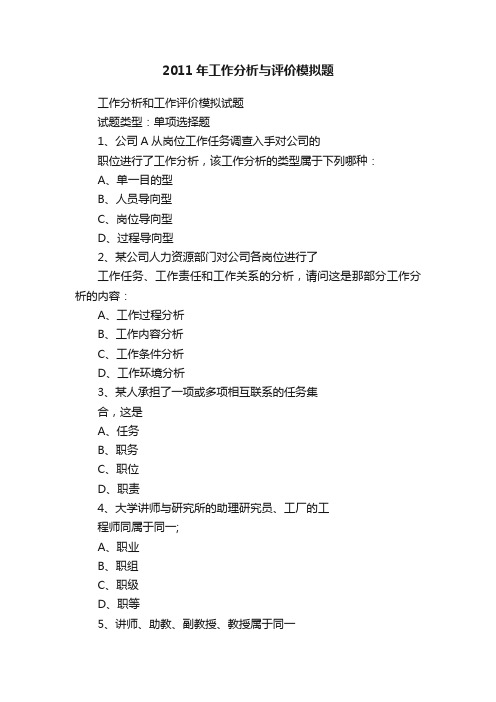
2011年工作分析与评价模拟题工作分析和工作评价模拟试题试题类型:单项选择题1、公司A从岗位工作任务调查入手对公司的职位进行了工作分析,该工作分析的类型属于下列哪种:A、单一目的型B、人员导向型C、岗位导向型D、过程导向型2、某公司人力资源部门对公司各岗位进行了工作任务、工作责任和工作关系的分析,请问这是那部分工作分析的内容:A、工作过程分析B、工作内容分析C、工作条件分析D、工作环境分析3、某人承担了一项或多项相互联系的任务集合,这是A、任务B、职务C、职位D、职责4、大学讲师与研究所的助理研究员、工厂的工程师同属于同一;A、职业B、职组C、职级D、职等5、讲师、助教、副教授、教授属于同一A、职业B、职组C、职级D、职等6、在公司中最直接,最原始、最基础的工作分析的结果是A、工作描述B、工作说明书C、资格说明书D、职位说明书7、对任职者心理品质的描述细致、突出重点,但是缺乏量估计,无法对所需的心理特征进行定量的分析,这种任职资格描述方式是:A、文字表述法B、表格法C、计分法D、定性法8、泰勒科学管理五大原则的第一原则是A、工作分析B、工作评价C、工作描述D、职责对等9、关键事件分析技术的开发者是()A、罗莫特B、约翰?弗拉纳根C、马克斯?韦伯D、泰勒10、同时考虑人员和工作两个变量,并将各种工作所需的基础技能和基础行为以一种标准化的形式罗列出来,这中工作分析工具是A、PAQB、FJAC、关键事件法D、任务清单11、工作分析的研究中,重视影响工作的普遍因素,而忽略某些偶然的个人因素的学者是A、斯科特B、约翰.沃特森C、巴鲁什D、迪兹12、斯科特工作分析研究的贡献是A、内行人的提出B、用途记录C、共有部分D、实现面谈考评的科学化13、下列说法中不正确的是()A.工作分析结果形式中最基础的就是编写工作描述B.工作分析的小组成员可以包括任职者、客户以及相关任何人C.职位说明书可以看作工作描述再生形式中最为完整的一种D.职能工作分析法最大的贡献在于提出了普通教育量表和个人特质分类方法14、以下三种工作分析方法,信度由高到低依次为( )A.PAQ>TTAS>JEMB.TTAS>JEM>PAQC.PAQ>JEM>TTASD.JEM>TTAS>PAQ15、用于衡量测量系统中反映同一因素的几个或多个项目之间的一致性的指标是A.再测信度B.评分者一致性信度C.内部一致性信度D.表面一致性信度16、关于利用观察法进行工作分析信息采集的优缺点,以下说法正确的A.可以基本排除主观因素的影响,比较客观和正确B.不适用于标准化的、周期短的、体力活动为主的工作C.工作量小,时间短D.特别有利于搜集有关任职资格方面要求的信息17、效标关联效度反映的是A.测量在多大范围内包含了概念的含义B.用来测量构念的变量与构念本身的一致性程度C.测评结果与某种标准结果的一致性程度D.重复测量同一研究对象时,得到相同研究结果的可能性18、在工作说明书中,描述工作场所以及工作的物理环境、安全环境和社会环境的部分是A.工作识别B.工作综述C.工作环境D.工作关系19、工作评价的因素比较法的发明者是A.马克斯?韦伯B.哈罗德?孔茨C.卡尔?波普D.尤金?本基20、对于一些工作周期较长和突发性事件较多的工作(如保安工作)进行工作分析,宜采取______进行分析。
深圳2011下半年会计证会计基础模拟试题及答案卷

C、会计科目的使用是否正确
D、凭证上反映的经济业务是否符合国家法律、行政法规和规章制度的规定
您未做该题正确答案:C
解析:本题的考点为原始凭制( )。【 】
A、现金收款凭证
B、银行付款凭证
C、转账凭证
D、现金收款凭证和银行付款凭证
10、某企业执行《小企业会计制度》,2008年1月1日以存款550万元购入B公司对外所发放股票的20%(B公司所有者权益总额为2500万元),能够对B公司产生重大影响。B公司2008年全年实现净利润100万元;当年宣告分配现金股利60万元。
(1)、 该企业2008年1月1日应确认的长期股权投资金额应为( )万元。【 】
C、财务数据统计资料
D、生产计划书
您未做该题正确答案:D
解析:本题的考点为会计档案的内容。生产计划书不是会计档案。
24、 记账凭证按其( )不同,通常分为收款凭证、付款凭证和转账凭证。【 】
A、格式
B、反映的经济内容
C、填列方式
D、依据的原始凭证
您未做该题正确答案:B
A、500
B、550
C、600
D、以上都不是
您未做该题正确答案:B
解析:无
(2)、 该企业2008年应确认的投资收益为( )万元。【 】
A、20
B、6
C、100
D、其他金额
您未做该题正确答案:A
解析:无
(3)、 对于B公司宣告的现金股利,该企业应贷记( )。【 】
A、投资收益
A、利润表
B、所有者权益变动表
C、资产负债表
D、现金流量表
2011年安全生产技术模拟题

《安全生产技术》模拟试题必作部分一、单项选择题(共60题,每题1分。
每题的备选项中,只有1个最符合题意)1.下列关于机械设计本质安全的说法,不正确的是()。
A.机械设计本质安全包括减少或避免在危险区域工作B.机械设计本质安全包括在设计中排除危险部件C.机械设计本质安全包括使用附加的安全装置D.机械设计本质安全包括不使用危险材料2.机床运转时,常见的异常有()。
A.刀具断裂B.工件飞出C.温升异常、转速异常D. 绞手3.机械制造场所工件、物料摆放不得超高。
在垛底与垛高之比为l:2的前提下,垛高不应超出()m(单位超高除外)。
A.2.0 B.4.0 C.3.0 D.5.04.冲压设备的安全装置按其结构分为机械、按钮、光电、感应等类型的安全装援。
其中,()全部属于机械式防护装置。
A.推手式装置、双手按钮式装置、光电式装置B.摆杆护手式装置、拉手式装置、光电式装置C.推手式装置、摆杆护手式装置、双手按钮式装置D.推手式装置、摆杆护手式装置、拉手式装置5.车间通道照明灯要覆盖所有通道,覆盖长度应大于车间安全通道长度的()。
A.50%B.60%C.80%D.90%6.()对钢丝绳的寿命起决定性的作用。
A.弯曲疲劳B.拉伸疲劳C.扭转疲劳D.挤压疲劳7.起重机吊钩断面形状最常用的是()。
A.圆形B.矩形C.梯形D.T字形8.在低压配电及防护系统中,下图表示( )系统。
A.TT B.TN-S C.TN-C-S D. TN-C9.电磁辐射危害是指电磁波形式的能量辐射造成的危害。
辐射电磁波是指频率()Hz以上的电磁波。
A.50 B.1000 C.10k D.100k10.保护接零的作用是()。
A.通过短路把故障部分电源断开B.增大导电电阻C.通过阻流D.降低故障电压11.在低压操作中,人体及其所携带的工具与带电体的距离不应小于()。
A. 1.5mB.1mC. 0.5mD.0.1m12.防止直接接触电击的措施是()。
2011年初级护师《儿科护理学》模拟试题
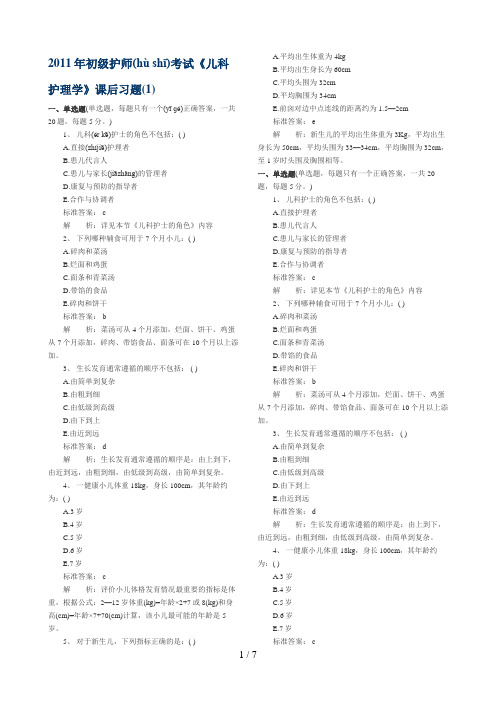
2011年初级护师(hù shī)考试《儿科护理学》课后习题(1)一、单选题(单选题,每题只有一个(yī ɡè)正确答案,一共20题,每题5分。
)1、儿科(ér kē)护士的角色不包括:( )A.直接(zhíjiē)护理者B.患儿代言人C.患儿与家长(jiāzhǎng)的管理者D.康复与预防的指导者E.合作与协调者标准答案: c解析:详见本节《儿科护士的角色》内容2、下列哪种辅食可用于7个月小儿:( )A.碎肉和菜汤B.烂面和鸡蛋C.面条和青菜汤D.带馅的食品E.碎肉和饼干标准答案: b解析:菜汤可从4个月添加,烂面、饼干、鸡蛋从7个月添加,碎肉、带馅食品、面条可在10个月以上添加。
3、生长发育通常遵循的顺序不包括: ( )A.由简单到复杂B.由粗到细C.由低级到高级D.由下到上E.由近到远标准答案: d解析:生长发育通常遵循的顺序是:由上到下,由近到远,由粗到细,由低级到高级,由简单到复杂。
4、一健康小儿体重18kg,身长100cm,其年龄约为:( )A.3岁B.4岁C.5岁D.6岁E.7岁标准答案: c解析:评价小儿体格发育情况最重要的指标是体重,根据公式:2—12岁体重(kg)=年龄×2+7或8(kg)和身高(cm)=年龄×7+70(cm)计算,该小儿最可能的年龄是5岁。
5、对于新生儿,下列指标正确的是:( )A.平均出生体重为4kgB.平均出生身长为60cmC.平均头围为32cmD.平均胸围为34cmE.前囟对边中点连线的距离约为1.5—2cm标准答案: e解析:新生儿的平均出生体重为3Kg,平均出生身长为50cm,平均头围为33—34cm,平均胸围为32cm,至1岁时头围及胸围相等。
一、单选题(单选题,每题只有一个正确答案,一共20题,每题5分。
)1、儿科护士的角色不包括:( )A.直接护理者B.患儿代言人C.患儿与家长的管理者D.康复与预防的指导者E.合作与协调者标准答案: c解析:详见本节《儿科护士的角色》内容2、下列哪种辅食可用于7个月小儿:( )A.碎肉和菜汤B.烂面和鸡蛋C.面条和青菜汤D.带馅的食品E.碎肉和饼干标准答案: b解析:菜汤可从4个月添加,烂面、饼干、鸡蛋从7个月添加,碎肉、带馅食品、面条可在10个月以上添加。
2011年温州市中考英语模拟试题及答案(附听力材料)

2011年温州市初中毕业生学业考试模拟卷英语试卷一、听力部分(计20分)I.听小对话,选择图片(共5小题;每小题1分,满分5分)1. What time is it now?2. What animal does the boy want to keep?A. B. C.3. What will the weather be like tomorrow?A. B. C.4.What sport does the man probably like better?A. B. C.5.How does the man go to work ?II.听小对话,回答问题(共5小题;每小题1分,满分5分)6. What does the man mean ?A. They won’t have any more cups . B . He doesn’t know why people liketea.C. They will get some more tea .7. When is the man going to decorate the room ?A. WednesdayB. SaturdayC. Tuesday8. What are they talking about ?A. NewspaperB. Their feelingsC. TV programs9.What is Roy doing ?A. He is calling Emma .B. He is talking to Emma face to face .C. He is answering Emma’s telephone .10.What does the man want to do?A. To change his walkman .B. To buy a new walkman .C. To borrowa walkman .III.听长对话,回答问题(共5小题;每小题1分,满分5分)听下面一段较长的对话,回答第11至第12两小题。
2011年银行从业人员资格考试《公共基础》模拟试题及答案
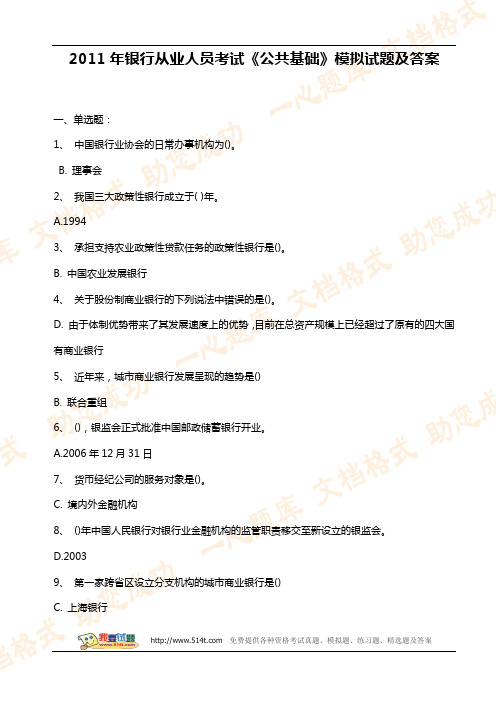
2011年银行从业人员考试《公共基础》模拟试题及答案一、单选题:1、中国银行业协会的日常办事机构为()。
B. 理事会2、我国三大政策性银行成立于( )年。
A.19943、承担支持农业政策性贷款任务的政策性银行是()。
B. 中国农业发展银行4、关于股份制商业银行的下列说法中错误的是()。
D. 由于体制优势带来了其发展速度上的优势,目前在总资产规模上已经超过了原有的四大国有商业银行5、近年来,城市商业银行发展呈现的趋势是()B. 联合重组6、 (),银监会正式批准中国邮政储蓄银行开业。
A.2006年12月31日7、货币经纪公司的服务对象是()。
C. 境内外金融机构8、 ()年中国人民银行对银行业金融机构的监管职责移交至新设立的银监会。
D.20039、第一家跨省区设立分支机构的城市商业银行是()C. 上海银行10、在下列机构中,可以经营的业务范围最广的是()。
A. 外商独资银行11、在现称为“五大行”的五家商业银行中,最早实行股份制的银行是(C),截至2007年4月尚未完成股份制改造的银行是()。
C. 交通银行,中国农业银行12、以下关于我国金融资产管理公司,说法不正确的是( )。
C. 我国四家金融资产管理公司业务上的发展方向是实行完全的政策性经营13、我国银行业正式全面对外开放是在()。
B.2006年12月1日14、《汽车金融公司管理办法》规定,经银监会批准,汽车金融公司可以从事()业务。
B. 提供购车贷款二、多选题:15、修订后的《中国人民银行法》规定中国人民银行的职责有()。
B. 监管黄金市场D. 监管银行间同业拆借市场和银行间债券市场16、银监会的监管理念包括( )。
A. 管风险B. 管法人C. 管内控D. 提高透明度17、 2007年1月召开的全国金融工作会议,关于政策性银行改革的决定有( )。
A. 三家政策性银行1994年一起成立,现在一起改革B. 首先推进进出口银行改革,以配合我国的汇率改革C. 首先推进国家开发银行改革,全面推进商业化运作,主要从事中长期业务D. 首先推进中国农业发展银行改革,支持新农村建设标准答案:c18、下述关于农村资金互助社的说法中正确的是( )。
2011年《教育学》仿真模拟试题(10)

2011年《教育学》仿真模拟试题(10)一、单项选择题(在每小题的四个备选答案中,选出一个正确的答案,并将其号码填在题干的括号内。
每小题1分,共20分)1()被人们看作是教育学形成独立学科的开始。
A、夸美纽斯的《大教学论》B、洛克的《教育漫话》C、卢梭的《爱弥尔》D、赫尔巴特的《普通教育学》2教育是年轻一代成长和社会延续与发展不可缺少的条件,为一切社会所必需,与人类社会共始终。
从这个意义上说,教育具有()。
A、生物性B、永恒性C、历史性D、阶级性3普通教育学的研究对象主要是()。
A、幼儿教育B、中、小学教育C、高等教育D、职业技术教育4广泛意义上的教育目的存在于()活动之中。
A、家庭教育B、社会教育C、学校教育D、一切教育5培养学生审美()能力是美育过程的起点。
A、感知B、理解C、判断D、创造6对人的身心发展来说,学校教育是一种()环境。
A、宏观的B、间接的C、一般的D、特殊的7()是现代学校教学的基本组织形式,它的出现在教育史上是一大进步。
A、课堂教学B、复式教学C、开放教学D、电化教学8教育过程主要矛盾的主要方面是()。
A、受教育者身心发展的现状B、受教育者身心发展的可能性C、教育要求D、教育影响9社会主义现代化建设不但需要高级科学技术专家,而且迫切需要大量素质良好的中、初级技术人员、管理人员、技工和其他城乡劳动者,所以必须大力发展()。
A、高等教育B、中等教育C、职业技术教育D、初等教育10教育者是教育过程中的基本要素之一,其基本特征是()。
A、主体性、示范性和目的性B、主体性、目的性和社会性C、主体性、个体性和社会性D、主体性、示范性和主动性11在思想品德教育过程中,知与行的统一,就是()。
A、理论加实践B、理论与实践有机结合C、读书加劳动D、感性认识与理性认识统一121985年《中共中央关于教育体制改革的决定》明确规定把发展()的责任交给地方。
A、基础教育B、中学教育C、中等教育D、职业教育13备课时,教师要按顺序写出()三种教学计划。
2011年10月 计算机应用基础

2011年10月自考计算机应用基础模拟试题一、单项选择题(本大题共34小题,每小题1分,共34分。
在每小题列出的四个备选项中只有一个是符合题目要求的,请将其代码填写在题后的括号内,错选、多选或未选均无分。
)1.下列选项中不属于微型计算机性能的是【】A.可靠性 B.性能价格比C.字长 D.抗病毒能力2.下列关于计算机存储器的叙述中,正确的是【】A.外存储器不能与CPU直接交换数据B.计算机断电后,内存储器中的信息将全部消失C.内存储器不能与CPU直接交换数据D.计算机断电后,软盘中的信息将全部消失3.目前广泛使用的“奔腾”型微机所采用的逻辑器件属于【】A.晶体管 B.电子管C.集成电路 D.超大规模集成电路4.计算机内存的每个存储单元都被赋予一个唯一的序号,这个序号称为【】A.地址 B.字节C.编号 D.比特5.在微型计算机中,能实现算术运算、逻辑运算以及进行控制的部件是【】A.中央处理器 B.存储器C.控制器 D.运算器6.在二进制数110101中,右起第5位数字是“1”,那么它的“权”值对应的十进制数是【】A.4 B.8C.16 D. 327.下列三种存储介质读取数据由快到慢的排列顺序为【】A.高速缓存、随机存储器、硬盘 B.高速缓存、硬盘、随机存储器C.硬盘、高速缓存、随机存储器 D.随机存储器、高速缓存、硬盘8.下列叙述正确的是【】A.计算机病毒不会将自身复制到内存中B.计算机病毒会传染到计算机的使用者C.计算机病毒可以把自身复制到计算机的硬盘D.经常运行的计算机程序会自动产生计算机病毒9.在Windows中,若窗口表示的是一个应用程序,则打开该应用程序窗口就是【】A.运行该应用程序 B.显示该应用程序的内容C.结束该应用程序的运行 D.将该窗口放大到最大10.在计算机内,一个浮点数的编码由两部分组成,它们是【】A.基数和尾数 B.阶码和尾数C.整数和小数 D.阶码和基数11.发现磁盘被计算机病毒感染之后,彻底清除病毒的方法是【】A.使用杀毒软件杀毒 B.删除磁盘内感染病毒的文件C.删除磁盘内的所有文件 D.做磁盘的格式化处理12.在Windows中,若要快速显示某个文件或文件夹的位置,可用“资源管理器”中的【】A.“前进”按钮 B.“搜索”按钮C.“向上”按钮 D.“查看”按钮13.在Windows中,“剪贴板”是【】A.硬盘中的一块区域 B.软盘中的一块区域C.光盘中的一块区域 D.内存中的一块区域14.在Windows中,要修改日期显示的格式应该在“控制面板”的【】A.“区域选项”中进行设置 B.“日期和时间”中进行设置C.“系统”中进行设置 D.“管理工具”中进行设置15.在Windows 2000操作系统中,文件管理的主要作用是【】A.实现对文件的按内容存取 B.实现按文件的属性存取C.实现文件的高速输入输出 D.实现对文件的按名存取16.在Windows 2000中,下列选项中不能为文件夹设置共享属性的是【】A.我的电脑 B.资源管理器C.控制面板 D.文件夹的右击菜单17.下列说法正确的是【】A.同一文件夹中不允许有两个文件的文件名完全相同B.不同文件夹中不允许有文件名相同的文件C,同一文件夹中允许有两个文件的文件名相同,但它们的内容也必须相同D.不同文件夹中允许有文件名相同的文件,但它们的内容也必须相同18.在Word中,若要查看文档的打印效果,下列选项中不可用的方法是【】A.水平滚动条左边的“页面视图”按钮B.“文件”菜单中的“打印预览”命令C,“常用”工具栏中的“打印预览”按钮D.“格式”菜单中的“样式”命令19.在Word文档内有一个三行四列的表格。
2011级高考文综模拟试题11
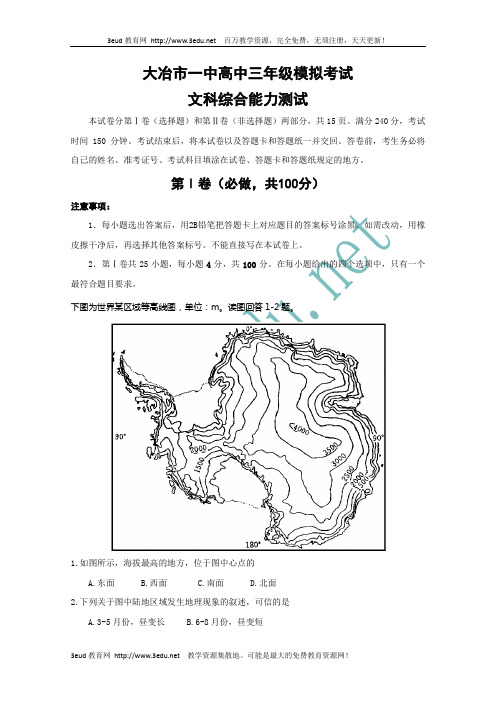
大冶市一中高中三年级模拟考试文科综合能力测试本试卷分第Ⅰ卷(选择题)和第Ⅱ卷(非选择题)两部分,共15页。
满分240分,考试时间150分钟。
考试结束后,将本试卷以及答题卡和答题纸一并交回。
答卷前,考生务必将自己的姓名、准考证号、考试科目填涂在试卷、答题卡和答题纸规定的地方。
第Ⅰ卷(必做,共100分)注意事项:1.每小题选出答案后,用2B铅笔把答题卡上对应题目的答案标号涂黑。
如需改动,用橡皮擦干净后,再选择其他答案标号。
不能直接写在本试卷上。
2.第Ⅰ卷共25小题,每小题4分,共100分。
在每小题给出的四个选项中,只有一个最符合题目要求。
下图为世界某区域等高线图,单位:m。
读图回答1-2题。
1.如图所示,海拔最高的地方,位于图中心点的A.东面B.西面C.南面D.北面2.下列关于图中陆地区域发生地理现象的叙述,可信的是A.3-5月份,昼变长B.6-8月份,昼变短C.9-11月份,昼变长D.12-次年2月,昼变短读下图回答3-4题。
3.图中字母与其所对应的地质构造和地貌,组合正确的是A.S-向斜-山谷 M-背斜-山地 V-断层-山谷B.S-背斜-山谷 M-向斜-山地 V-断层-山谷C.S-向斜-山谷 M-断层-山谷 V-背斜-山地D.S-断层-山谷 M-向斜-山谷 V-背斜-山地4.图中所示的地形类型主要是A.山地B.高原C.丘陵D.平原读下图回答5-6题。
5.图中所示的水资源类型是①淡水②咸水③生产用水④生活用水A.①②B.③④C.②③D.①④6.下列关于图示设施的叙述,正确的是①合理利用了水循环中的降水环节②合理利用了水循环中的地下径流环节③比较适用于城市区域④比较适用于农村区域A.①②B.③④C.①③D.②④文化创意产业是指依靠创意人的智慧、技能和天赋,借助于高科技对文化资源进行创造与提升,产生出高附加值产品的产业。
读我国某城市文化创意公司空间分布图,回答7-8题。
7.读图可知,影响文化创意公司区位的主导因素应是①市场②环境③交通④劳动力A.①②B.③④C.①③D.②④8.文化创意公司之间的工业联系,产生的效益有①加强信息交流②加强技术协作③降低运输费用④减少能源消耗A.①②B.③④C.①③D.②④9.中华几千年的文明为我们留下了丰富的文物,从中可以获取丰富的历史信息。
2011年CAD资格认证模拟考试
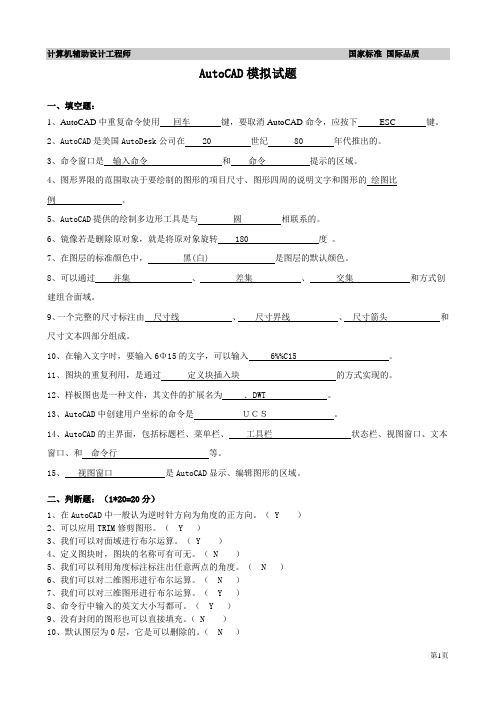
计算机辅助设计工程师国家标准国际品质AutoCAD模拟试题一、填空题:1、AutoCAD中重复命令使用回车键,要取消AutoCAD命令,应按下ESC 键。
2、AutoCAD是美国AutoDesk公司在 20 世纪 80 年代推出的。
3、命令窗口是输入命令和命令提示的区域。
4、图形界限的范围取决于要绘制的图形的项目尺寸、图形四周的说明文字和图形的绘图比例。
5、AutoCAD提供的绘制多边形工具是与圆相联系的。
6、镜像若是删除原对象,就是将原对象旋转 180 度。
7、在图层的标准颜色中,黑(白) 是图层的默认颜色。
8、可以通过并集、差集、交集和方式创建组合面域。
9、一个完整的尺寸标注由尺寸线、尺寸界线、尺寸箭头和尺寸文本四部分组成。
10、在输入文字时,要输入6Φ15的文字,可以输入 6%%C15 。
11、图块的重复利用,是通过定义块插入块的方式实现的。
12、样板图也是一种文件,其文件的扩展名为.DWT 。
13、AutoCAD中创建用户坐标的命令是UCS。
14、AutoCAD的主界面,包括标题栏、菜单栏、工具栏状态栏、视图窗口、文本窗口、和命令行等。
15、视图窗口是AutoCAD显示、编辑图形的区域。
二、判断题:(1*20=20分)1、在AutoCAD中一般认为逆时针方向为角度的正方向。
( Y )2、可以应用TRIM修剪图形。
( Y )3、我们可以对面域进行布尔运算。
( Y )4、定义图块时,图块的名称可有可无。
( N )5、我们可以利用角度标注标注出任意两点的角度。
( N )6、我们可以对二维图形进行布尔运算。
( N )7、我们可以对三维图形进行布尔运算。
( Y )8、命令行中输入的英文大小写都可。
( Y )9、没有封闭的图形也可以直接填充。
( N )10、默认图层为0层,它是可以删除的。
( N )11、单独的一根线也可以通过修剪来删除。
( N )12、正交功能打开时就只能画水平或垂直的线段。
( Y )13、所有图层均可加锁,也可以关闭所有图层。
2011全国各地中考历史模拟试题分类汇编11《三次科技革命》1

2011年全国各地中考历史模拟试题分类汇编十一、三次科技革命选择题1.(2011郑州市中考一模)第一批手机只能用来接打电话,网络网出现时只能在电脑之间运行。
目前手机上网已经成为了一种时尚。
这表明第三次科技革命与前两次科技革命相比的特点是A.加强了世界的联系B.科技的各个领域之间相互渗透C.新技术引起了国际经济格局的变化D.世界开始形成一个整体答案:B2.(2011河南信阳一中中考一模)工业革命,第二次工业革命和第三次科技革命是人类历史上的三次科技革命,其共同之处在于A.使人类进入电气时代 B.从发明和使用机器开始C.计算机网络技术的广泛应用 D.促进生产力发展,改变人类生活答案:D3.(2011南京三中一模)下列哪一幅图片不属于第三次科技革命的成果?A B C D答案:D4.(2011九年级学业检查)甬台温铁路通车,实现了台州人民的百年夙愿。
火车最早的发明者是A.瓦特 B.哈格里夫斯 C.史蒂芬孙 D.福特答案:C5.(2011河南信阳一中中考一模)以下是英国在文化、政治、经济领域涌现出的杰出人物,其中直接推动了工业革命的是答案:C6.(2011芜湖市29中一模)第三次科技革命具有范围广、影响大的特点,它给人类的生产和生活带来巨大的变化。
下列选项中属于第三次科技革命成果的是A.蒸汽机和火车 B.计算机和航天技术 C.轮船和汽车 D.内燃机和飞机答案:B7.(2011郑州市中考一模)美国华裔能源部长朱棣文曾表示:“第一次工业革命让人类摆脱劳力与使用牛马等动物帮忙的生活,但成本却带来让人类暴露在二氧化碳的污染下。
下次工业革命将会使人类在享受便利能源之余,对于环境的污染也会相对减少。
”朱棣文所指的这种对“环境污染相对减少”的“便利能源”是A.煤B.水C.石油D.电答案:D8.(2011江苏省南京市高淳一调)现在各款汽车纷纷进入寻常百姓家庭,世上第一辆投入实际使用的汽车是▲制成的A.卡尔·本茨 B.莱特兄弟 C.史蒂芬孙 D.富尔顿答案:A9.1851年首届世界博览会在英国伦敦举行,以下工业成果最有可能参展的是A、飞机B、电话C、蒸汽机D、计算机答案:C10.(2011年漳州市高中招生模拟)2008年5月12日14时28分,我国四川地区发生了大地震。
2011年中医执业助理医师资格考试模拟试题及答案

2011年中医执业助理医师资格考试模拟试题及答案1.我国现存最早的医学专著是A.《五十二产病方》B.《神农本草经》C.《黄帝内经》D.《中藏经》E.《伤寒论》答案:C2.中医四大经典著作是A.《黄帝内经》、《神农本草经》、《伤寒论》、《金匮要略》B.《黄帝内经》、《伤寒论》、《类经》、《难经》C.《素问》、《灵枢》、《神农本草经》、《伤寒论》D.《黄帝内经》、《类经》、《难经》、《脉经》E.《素问》、《灵枢》、《神农本草经》、《中藏经》答案:A3.中医理论体系的主要特点是A.急则治标、缓则治本B.辨病与辨证相结合C.整体观念和辨证论治D.异病同治和同病异治E.以上都不是答案:C4.中医精气神学说中"神"的含义是指A.人体生命活动的主宰B.人的精神意识C.人体生命的基本物质D.人体生命活动的动力E.以上都不是答案:A5.中医精气神学说的"精。
"。
是指A.先天之精B.水谷之精C.气、血、津、液D.肾中所藏之精E.以上都不是答案:D6.阴阳学说较准确的说法是A.中医的经典理论B.我国古代的一种哲学思想C.对立统一的世界观D.唯物论E.我国古代朴素的唯物论和自发的辨证法思想答案:E7.事物阴阳两个方面的相互转化是A.量的变B.单方面的C.有条件的D.绝对的E.必然的答案:C8.《内经》:"阴在内,阳之守也,阳在外,阴之使也"是说明阴阳之间的A.相互转化B.相生相克C.相互对立D.互根互用E.消长平衡答案:D9.以下哪种情况最易说明阴消阳长的相互转化:A.一种能量转变成另一种能量B.水变成冰C.内转变为外D.云转为雨E.物质转化为精神答案:E10.根据"诸寒之而热者取之阴"的法则,治宜:A.热者寒之B.寒者热之C.壮水制火D.益火消阴E.以上都不是答案:C11.病先见持续高热,面红目赤,后突然见。
肢厥面白,脉微欲绝,证属A.阳消阴长B.阳胜则热C.阴盛则寒D.寒极生热E.重阳必阴答案:E12."重阴必阳"、"重阳必阴"属于A.阴阳的互根B.阴阳的对立C.阴阳的转化D.阴阳的消长E.阴阳的相互制约答案:C13.古人提出,"春夏养阳,秋冬养阴"旨在强调A.春夏重在保养阳气B.秋冬重在保养阴气C.保养阳气的重要性D.保养阴气的重要性E.调养四时阴阳的重要性答案:E14."孤阴不生,独阳不长"是由于阴阳之间哪种关系失常A.互根互用B.消长平衡C.阴阳交感D.对立制约E.相互转化答案:A15.防治疾病的基本原则是A.扶正却邪B.泻实补虚C.调理阴阳D.却除病邪E.补益正气答案:C16.根据五行的生克乘侮规律,若土气不足,则A.木乘土,金侮土B.木乘土,水侮土C.木侮土,水乘土D.土乘木,水侮土E.土乘水,木侮木答案:B17.根据五行的生克乘侮规律,以下哪种说法是错误的A.心火不足,肾水可乘之B.木火刑金C.肝木乘土D.心火过亢,可以反侮肺金E.岁土太过,雨湿流行,肾水受邪答案:D18.按五行生克规律,以下哪种说法是错误的A.火为土之母B.金为木之所胜C.水为火之所不胜D.木为水之子E.金为土之子答案:B19.根据五行的生克乘侮规律制定的治疗法。
考驾照c1科目一模拟试题2011
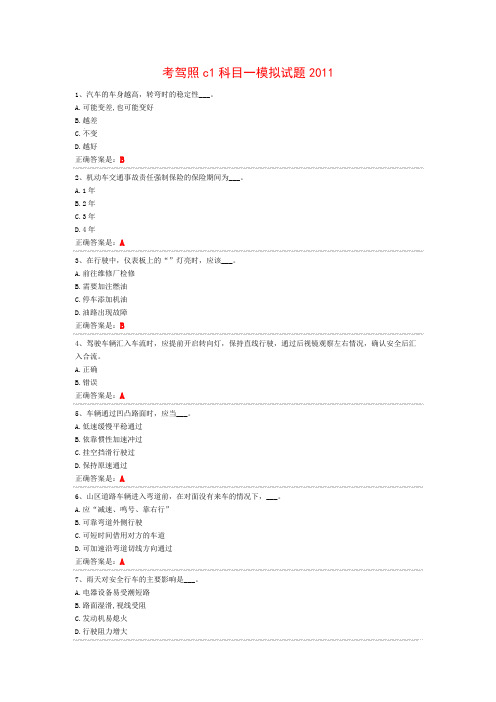
考驾照c1科目一模拟试题20111、汽车的车身越高,转弯时的稳定性___。
A.可能变差,也可能变好B.越差C.不变D.越好正确答案是:B2、机动车交通事故责任强制保险的保险期间为___。
A.1年B.2年C.3年D.4年正确答案是:A3、在行驶中,仪表板上的“”灯亮时,应该___。
A.前往维修厂检修B.需要加注燃油C.停车添加机油D.油路出现故障正确答案是:B4、驾驶车辆汇入车流时,应提前开启转向灯,保持直线行驶,通过后视镜观察左右情况,确认安全后汇入合流。
A.正确B.错误正确答案是:A5、车辆通过凹凸路面时,应当___。
A.低速缓慢平稳通过B.依靠惯性加速冲过C.挂空挡滑行驶过D.保持原速通过正确答案是:A6、山区道路车辆进入弯道前,在对面没有来车的情况下,___。
A.应“减速、鸣号、靠右行”B.可靠弯道外侧行驶C.可短时间借用对方的车道D.可加速沿弯道切线方向通过正确答案是:A7、雨天对安全行车的主要影响是___。
A.电器设备易受潮短路B.路面湿滑,视线受阻C.发动机易熄火D.行驶阻力增大正确答案是:B8、通过窄路、窄桥时,不得超车。
A.正确B.错误正确答案是:A9、驾驶人夜间行车遇对向灯光照射后,短时间内仍能看清前方道路情况。
A.正确B.错误正确答案是:B10、机动车向左转弯、向左变更车道、超车前、驶离停车地点及掉头时,___。
A.可以在转向的同时开启转向灯B.可以先转向后开启转向灯C.只要没有其他车辆可以不开转向灯D.应当提前开启左转向灯正确答案是:D11、图中标志的含义是___。
A.限制宽度3米B.限制高度3米C.解除限制宽度D.预告桥宽3米正确答案是:A12、驾驶人___,承担交通事故全部责任。
A.与行人发生事故的B.与非机动发生事故的C.故意破坏、伪造现场、毁灭证据的D.与对方机动车发生事故的正确答案是:C13、可以扣留机动车驾驶证的情形是___。
A.饮酒后驾驶机动车的B.驾车时吸烟、饮食的C.发生轻微交通事故,未造成财产损失的D.机动车行驶超过规定时速10%的正确答案是:A14、行车途中,仪表板上的“”灯亮起,表示机油量可能不足、机油压力过低。
2011年人力1-10章习题及答案
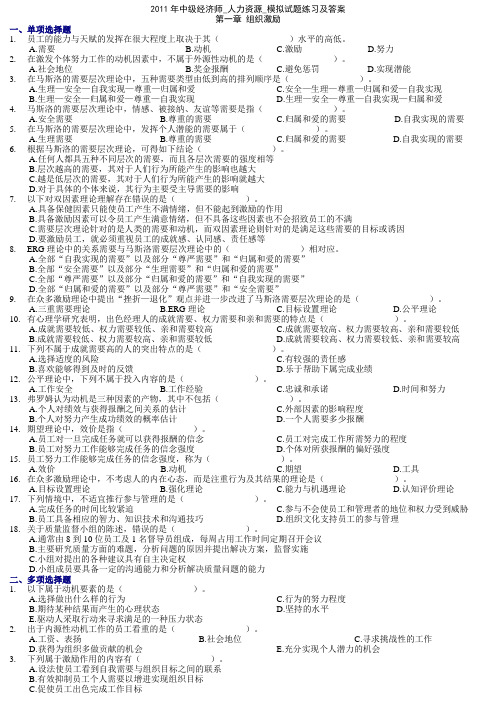
2011年中级经济师_人力资源_模拟试题练习及答案第一章组织激励一、单项选择题1. 员工的能力与天赋的发挥在很大程度上取决于其()水平的高低。
A.需要B.动机C.激励D.努力2. 在激发个体努力工作的动机因素中,不属于外源性动机的是()。
A.社会地位B.奖金报酬C.避免惩罚D.实现潜能3. 在马斯洛的需要层次理论中,五种需要类型由低到高的排列顺序是()。
A.生理—安全—自我实现—尊重—归属和爱B.生理—安全—归属和爱—尊重—自我实现C.安全—生理—尊重—归属和爱—自我实现D.生理—安全—尊重—自我实现—归属和爱4. 马斯洛的需要层次理论中,情感、被接纳、友谊等需要是指()。
A.安全需要B.尊重的需要C.归属和爱的需要D.自我实现的需要5. 在马斯洛的需要层次理论中,发挥个人潜能的需要属于()。
A.生理需要B.尊重的需要C.归属和爱的需要D.自我实现的需要6. 根据马斯洛的需要层次理论,可得如下结论()。
A.任何人都具五种不同层次的需要,而且各层次需要的强度相等B.层次越高的需要,其对于人们行为所能产生的影响也越大C.越是低层次的需要,其对于人们行为所能产生的影响就越大D.对于具体的个体来说,其行为主要受主导需要的影响7. 以下对双因素理论理解存在错误的是()。
A.具备保健因素只能使员工产生不满情绪,但不能起到激励的作用B.具备激励因素可以令员工产生满意情绪,但不具备这些因素也不会招致员工的不满C.需要层次理论针对的是人类的需要和动机,而双因素理论则针对的是满足这些需要的目标或诱因D.要激励员工,就必须重视员工的成就感、认同感、责任感等8. ERG理论中的关系需要与马斯洛需要层次理论中的()相对应。
A.全部“自我实现的需要”以及部分“尊严需要”和“归属和爱的需要”B.全部“安全需要”以及部分“生理需要”和“归属和爱的需要”C.全部“尊严需要”以及部分“归属和爱的需要”和“自我实现的需要”D.全部“归属和爱的需要”以及部分“尊严需要”和“安全需要”9. 在众多激励理论中提出“挫折—退化”观点并进一步改进了马斯洛需要层次理论的是()。
2011年初中数学模拟试题(11)
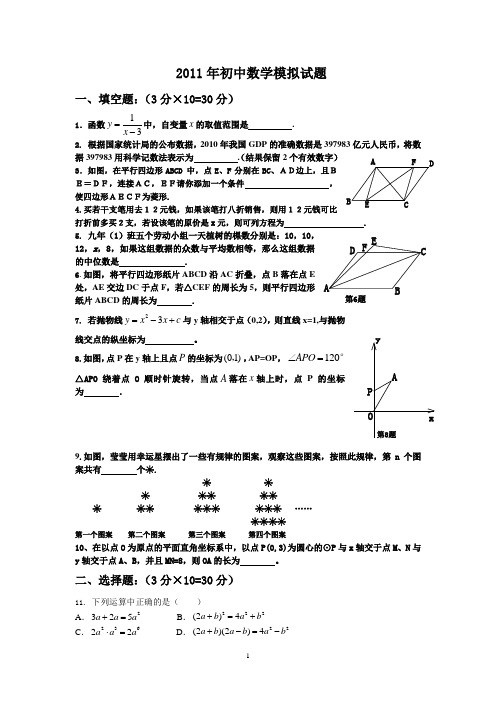
2011年初中数学模拟试题一、填空题:(3分×10=30分)1.函数13yx =-中,自变量x 的取值范围是 . 2. 根据国家统计局的公布数据,2010年我国GDP 的准确数据是397983亿元人民币,将数据397983用科学记数法表示为 .(结果保留2个有效数字)3.如图,在平行四边形ABCD 中,点E 、F 分别在BC 、AD边上,且BE=DF,连接AC,EF请你添加一个条件 ,使四边形AECF为菱形.4.买若干支笔用去12元钱,如果该笔打八折销售,则用12元钱可比打折前多买2支,若设该笔的原价是x 元,则可列方程为 .5. 九年(1)班五个劳动小组一天植树的棵数分别是:10,10,12,x ,8,如果这组数据的众数与平均数相等,那么这组数据的中位数是 .6.如图,将平行四边形纸片ABCD 沿AC 折叠,点B 落在点E 处,AE 交边DC 于点F ,若△CEF 的周长为5,则平行四边形纸片ABCD 的周长为 .7. 若抛物线23y x x c =-+与y 轴相交于点(0,2),则直线x=1,与抛物线交点的纵坐标为 。
8.如图,点P 在y 轴上且点P 的坐标为(01),,AP=OP , 120APO ∠=°△APO 绕着点O 顺时针旋转,当点A 落在x 轴上时,点P 的坐标为 .9.如图,莹莹用幸运星摆出了一些有规律的图案,观察这些图案,按照此规律,第n 个图案共有 个☀.☀ ☀ ☀ ☀☀ ☀☀☀ ☀☀ ☀☀☀ ☀☀☀ ……☀☀☀☀第一个图案 第二个图案 第三个图案 第四个图案10、在以点O 为原点的平面直角坐标系中,以点P(0,3)为圆心的⊙P 与x 轴交于点M 、N 与y 轴交于点A 、B ,并且MN=8,则OA 的长为 。
二、选择题:(3分×10=30分)11. 下列运算中正确的是( )A .2325a a a +=B .222(2)4a b a b +=+C .23622a a a ⋅=D .22(2)(2)4a b a b a b +-=-ABD FE第6题P A O yx第8题ABE CDF12. 观察下列银行标志,从图案看既是轴对称图形又是中心对称图形的有( )A .1个B .2个C .3个D .413.下面四个几何体中,主视图与俯视图不同的共有( )A.1个B.2个C.3个D.4个14.小红的爷爷每天坚持体育锻炼.某天他慢步到离家较远的人民公园,打了一会儿太极拳后跑步回家.下面能反映当天小红的爷爷离家的距离y 与时间x 的函数关系的大致图象是( )15.在一个不透明的袋中,装有若干个除颜色不同外其余都相同的球,如果袋中有3个红球且摸到红球的概率为14,那么袋中球的总个数为( ) A .15个 B. 12个 C. 9个 D. 3个 16.反比例函数ky x =的图象如图所示,则k 的值可能是( ). (A )1-2(B )12 (C )5-3 (D )5317.若二次函数2y ax bx c =++中,a >0,c <0,则下列图像中正确的是( )。
2011年中考英语模拟考试试题——11
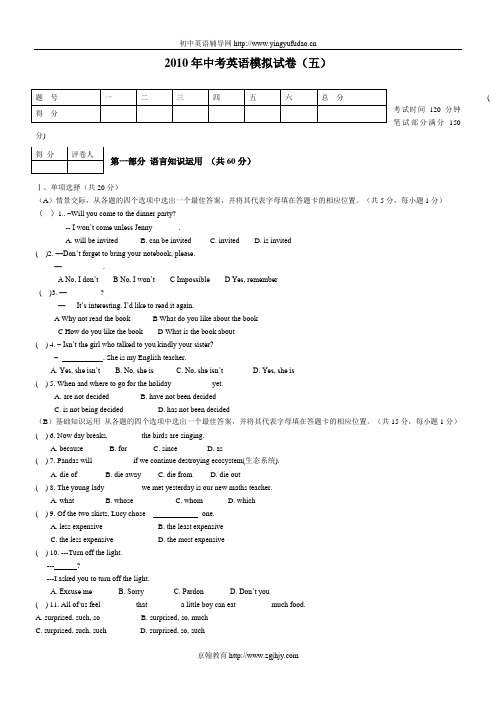
2010年中考英语模拟试卷(五)(考试时间120分钟 笔试部分满分150分)第一部分 语言知识运用 (共60分)Ⅰ、单项选择(共20分)(A )情景交际,从各题的四个选项中选出一个最佳答案,并将其代表字母填在答题卡的相应位置。
(共5分,每小题1分) ( )1.. –Will you come to the dinner party? -- I won‘t come unless J enny_______.A. will be invitedB. can be invitedC. invitedD. is invited ( )2. —Don‘t forget to bring your notebook, please. —___________.A No, I don‘tB No, I won‘tC ImpossibleD Yes, remember ( )3. —_________?— It‘s interesting. I‘d like to read it again.A Why not read the bookB What do you like about the bookC How do you like the bookD What is the book about ( ) 4. – Isn‘t the girl who talked to you kindly your sister?– . She is my English teacher.A. Yes, she isn‘tB. No, she isC. No, she isn‘tD. Yes, she is ( ) 5. When and where to go for the holiday __________ yet. A. are not decided B. have not been decided C. is not being decidedD. has not been decided(B )基础知识运用 从各题的四个选项中选出一个最佳答案,并将其代表字母填在答题卡的相应位置。
2011年司法考试《卷一》模拟试题及答案含答案和详细解析
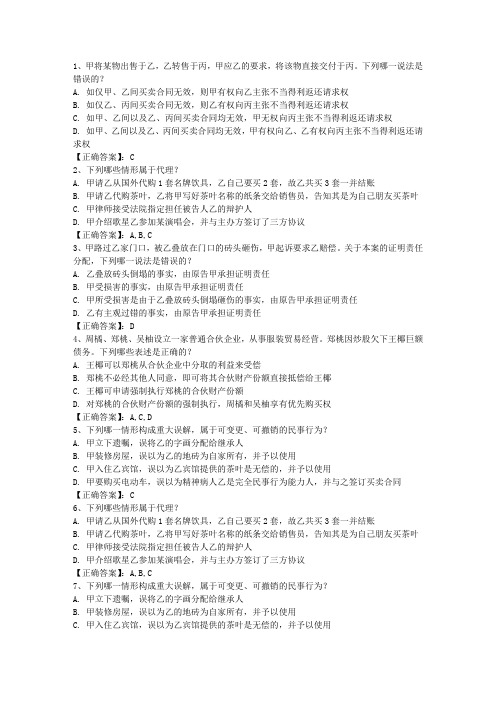
1、甲将某物出售于乙,乙转售于丙,甲应乙的要求,将该物直接交付于丙。
下列哪一说法是错误的?A. 如仅甲、乙间买卖合同无效,则甲有权向乙主张不当得利返还请求权B. 如仅乙、丙间买卖合同无效,则乙有权向丙主张不当得利返还请求权C. 如甲、乙间以及乙、丙间买卖合同均无效,甲无权向丙主张不当得利返还请求权D. 如甲、乙间以及乙、丙间买卖合同均无效,甲有权向乙、乙有权向丙主张不当得利返还请求权【正确答案】:C2、下列哪些情形属于代理?A. 甲请乙从国外代购1套名牌饮具,乙自己要买2套,故乙共买3套一并结账B. 甲请乙代购茶叶,乙将甲写好茶叶名称的纸条交给销售员,告知其是为自己朋友买茶叶C. 甲律师接受法院指定担任被告人乙的辩护人D. 甲介绍歌星乙参加某演唱会,并与主办方签订了三方协议【正确答案】:A,B,C3、甲路过乙家门口,被乙叠放在门口的砖头砸伤,甲起诉要求乙赔偿。
关于本案的证明责任分配,下列哪一说法是错误的?A. 乙叠放砖头倒塌的事实,由原告甲承担证明责任B. 甲受损害的事实,由原告甲承担证明责任C. 甲所受损害是由于乙叠放砖头倒塌砸伤的事实,由原告甲承担证明责任D. 乙有主观过错的事实,由原告甲承担证明责任【正确答案】:D4、周橘、郑桃、吴柚设立一家普通合伙企业,从事服装贸易经营。
郑桃因炒股欠下王椰巨额债务。
下列哪些表述是正确的?A. 王椰可以郑桃从合伙企业中分取的利益来受偿B. 郑桃不必经其他人同意,即可将其合伙财产份额直接抵偿给王椰C. 王椰可申请强制执行郑桃的合伙财产份额D. 对郑桃的合伙财产份额的强制执行,周橘和吴柚享有优先购买权【正确答案】:A,C,D5、下列哪一情形构成重大误解,属于可变更、可撤销的民事行为?A. 甲立下遗嘱,误将乙的字画分配给继承人B. 甲装修房屋,误以为乙的地砖为自家所有,并予以使用C. 甲入住乙宾馆,误以为乙宾馆提供的茶叶是无偿的,并予以使用D. 甲要购买电动车,误以为精神病人乙是完全民事行为能力人,并与之签订买卖合同【正确答案】:C6、下列哪些情形属于代理?A. 甲请乙从国外代购1套名牌饮具,乙自己要买2套,故乙共买3套一并结账B. 甲请乙代购茶叶,乙将甲写好茶叶名称的纸条交给销售员,告知其是为自己朋友买茶叶C. 甲律师接受法院指定担任被告人乙的辩护人D. 甲介绍歌星乙参加某演唱会,并与主办方签订了三方协议【正确答案】:A,B,C7、下列哪一情形构成重大误解,属于可变更、可撤销的民事行为?A. 甲立下遗嘱,误将乙的字画分配给继承人B. 甲装修房屋,误以为乙的地砖为自家所有,并予以使用C. 甲入住乙宾馆,误以为乙宾馆提供的茶叶是无偿的,并予以使用D. 甲要购买电动车,误以为精神病人乙是完全民事行为能力人,并与之签订买卖合同【正确答案】:C8、甲育有二子乙和丙。
考驾照模拟试题2011 完整版

考驾照模拟试题2011 完整本1、驾驶人在超车时,发现前方车辆正在超车时,应()。
A、紧跟其后,伺机超越B、加速强行超越C、连续鸣喇叭催前车让路D、停止超车正确答案:D2、机动车第三者责任强制保险(又称交通事故责任强制保险)赔偿的责任对象是发生交通事故造成()人身伤亡、财产损失,在责任限额内予以赔偿。
A、驾驶人B、本车人员、被保险人以外的受害人C、被保险人D、乘车人正确答案:B3、车辆通过立交桥左转弯时,应()。
A、先观察交通标志,后按标线的引导行驶B、先观察标线,后按照交通标志行驶C、不观察标志标线,过桥前先右转弯D、不观察标志标线,上桥后寻找出口正确答案:A4、驾驶人超车时,前方车辆不让出超车空间,应()。
A、迅速超越B、停止超车C、连续鸣喇叭超越D、开启前照灯超越正确答案:B5、图中所示均是()标线。
A、禁驶区B、禁停区C、中心圈D、简化网状<>正确答案:C6、伪造、变造或者使用伪造、变造的机动车保险标志的,由公安机关交通管理部门予以收缴,(),并处200元以上2000元以下罚款。
A、注销行驶证B、吊销驾驶证C、拘留驾驶人D、扣留该机动车正确答案:D7、行车中遇抢救伤员的救护车从本车道逆向驶来时,应()。
A、靠边减速或停车让行B、占用其他车道行驶C、加速变更车道避让D、在原车道内继续行驶正确答案:A8、中心双实线表示()。
A、车辆在对面无车的情况下可以越线行驶B、严格禁止车辆越线超车、向左转弯或压线行驶C、在对面无车的情况下可以左转弯D、在确保安全的情况下,可以压线超车正确答案:B9、行车途中,仪表板上的“ ”灯亮时,表示()。
A、发动机机油量不足、压力过低B、制动液泄漏C、燃油有泄漏D、发动机机油量过多、压力过高<>正确答案:A10、发生物损价值在()以下、没有人员伤亡的交通事故,当事人可以直接向保险公司报告和申请定损,保险公司应当及时派员处理,依照法律规定和合同约定理赔。
2011年电子商务师考试模拟测试题及答案
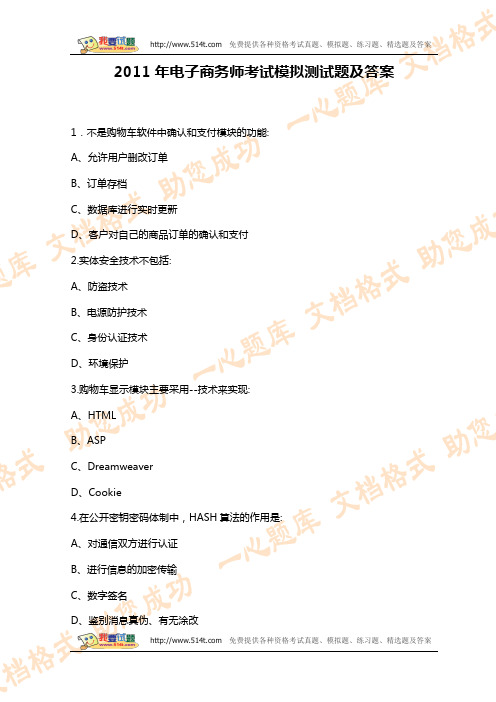
2011年电子商务师考试模拟测试题及答案1.不是购物车软件中确认和支付模块的功能:A、允许用户删改订单B、订单存档C、数据库进行实时更新D、客户对自己的商品订单的确认和支付2.实体安全技术不包括:A、防盗技术B、电源防护技术C、身份认证技术D、环境保护3.购物车显示模块主要采用--技术来实现:A、HTMLB、ASPC、DreamweaverD、Cookie4.在公开密钥密码体制中,HASH算法的作用是:A、对通信双方进行认证B、进行信息的加密传输C、数字签名D、鉴别消息真伪、有无涂改5.使用电子钱包进行网上支付前,必须输入:A、卡的账号B、数字证书C、银行卡账户信息D、卡的种类6.假定(1)登陆商家网站(2)选择中银电子钱包付款(3)浏览商品,并放入购物车或购物篮(4)确认订购信息完成交易,则使用电子钱包的工作程序为:A. (1)(3)(2)(4)(5)B. (1)(2)(3)(4)(5)C. (3)(4)(1)(2)(5)D. (5)(4)(2)(1)(2)7.当您订购的商品出现质量或其它问题时,您要与商家联系,这时商家会要求您提供商品的:A 订购单号B购买金额C商城名称D商品描述8.电子支付采用先进的技术通过--来完成信息传输的:A、数字流转B、现金流转C、票据的流转D、电子货币的流转9.智能卡的结构不包括A、建立智能卡的程序编制器B、处理智能卡操作系统的代理C、嵌入式微型控制器D、作为智能卡应用程序接口的代理10.在进行网上单证的流程设计时,流程处理改善遵循的基本原则不包括:A、在瓶颈处添加额外资源B、删除不增值工序C、串行处理D、减少等待11.关于电子钱包说法不正确的是:A、是在小额购物或购买小商品时常用的新式钱包B、具有信息存储的功能C、以借记卡为电子钱包的电子现金支付系统D、具有安全解码锁的功能12.实体安全技术包括:A、电源防护技术B、防盗技术C、环境保护D、电磁兼容性13.电子钱包是一个在SET交易中,运行在--端的软件。
2011年高考广东英语模拟试题

2011年高考广东英语模拟试题第一部分语言知识及应用(共两节,满分45分)第一节完形填空(共15小题;每小题2分,满分30分)阅读下面短文,掌握其大意,然后从1~15各题所给的A、B、C和D项中,选出最佳选项,并在答题卡上将该项涂黑。
There is a true story about a young lady who got so sick of living with her strict parents that she ran away from home. However, she soon found out that 1 was not easy on her own. She couldn’t find a job, and it didn’t take long for her friends to get2 her so they kicked her out. Well, this young 19-year-old girl got so3 that she decided to start making money by begging.Years passed. Her father died. Her mother grew older. But she still would not write or go home to see her4 . One day, the mother 5 that her daughter was seen in a certain part of town,so shewentthere6 her daughter. She went to every store and cheap hotel asking to put a picture of herself, now a gray-haired woman, on their walls. Beside her picture was this message to her daughter which simply7 : “I still love you! Please come home!”Months 8 and nothing happened. Then one day the daughter wandered into one of those hotels. You can imagine how 9she was to see her mother’s picture on the wall of that dirty, cheap hotel. As she read her mother’s message to her, she burst into 10 .That night she started walking many miles back to her home. It was in the early morning that she finally arrived at the front door of her parents’ house. She began to 11 but the door was already open. Afraid that someone had 12 the house, she 13 inside and woke up the sleeping old lady and told her she had finally come home. Mother and daughter began to cry as they held each other. The daughter said, “I thought someone had broken open the door!” But the mother14 her head and answered 15 , “My dear, from the day you left I’ve kept the door unlocked.”1. A. life B. studyC. societyD. work2. A. interested in B. fond ofC. tired ofD. worried about3. A. satisfied B. hopelessC. homelessD. excited4. A. father B. friendC. sisterD. mother5. A. saw B. heardC. noticedD. listened6. A. asking for B. finding outC. looking forD. searching for7. A. said B. toldC. wroteD. signed8. A. passed B. returnedC. changedD. went9. A. disappointed B. shockedC. confusedD. pleased10. A. laughter B. fearC. angerD. tears11. A. kick B. lockC. shoutD. knock12. A. broken out B. broken downC. broken intoD. broken up13. A. entered B. ranC. walkedD. wandered14. A. shook B. noddedC. bentD. bowed15. A. firmly B. loudlyC. gentlyD. regretfully第二节语法填空(共10小题;每小题1.5分,满分15分)阅读下面短文,按照句子结构的语法性和上下文连贯的要求,在空格处填入一个适当的词或使用括号中词语的正确形式填空,并将答案填写在答题卡标号为16~25的相应位置上。
- 1、下载文档前请自行甄别文档内容的完整性,平台不提供额外的编辑、内容补充、找答案等附加服务。
- 2、"仅部分预览"的文档,不可在线预览部分如存在完整性等问题,可反馈申请退款(可完整预览的文档不适用该条件!)。
- 3、如文档侵犯您的权益,请联系客服反馈,我们会尽快为您处理(人工客服工作时间:9:00-18:30)。
2011年专四考试模拟试题(阅读篇11)
The status of women in colonial North America has been well studied and describe d and can be briefly summarized. Throughout the colonial period there was a mark ed shortage of women, which varied with the regions and was always greatest in t he frontier areas. This favorable ratio enhanced women’s status and position and allowed them to pursue different careers. The Puritans, the religious sect that dominated the early British colonies in North America, regarded idleness as a s in, and believed that life in an underdeveloped country made it absolutely neces sary that each member of the community perform an economic function. Thus work f or women, married or single, was not only approved, it was regarded as a civic d uty. Puritan town councils expected widows and unattached women to be self supp orting and for a long time provided needy spinsters with parcels of land. There was no social sanction against married women working; on the contrary, wives wer e expected to help their husbands in their trade and won social approval for doi ng extra work in or out of the home. Needy children, girls as well as boys, were indentured or apprenticed and were expected to work for their keep.
The vast majority of women worked within their homes, where their labor produced most articles needed for the family. The entire colonial production of cloth an d clothing and partially that of shoes was in the hands of women. In addition to these occupations, women were found in many different kinds of employment. They were butchers, silversmiths, gunsmiths, and upholsterers. They ran mills, plant ations, tanyards, shipyards, and every kind of shop, tavern, and boardinghouse. They were gatekeepers, jail keepers, sextons, journalists, printers, apothecarie s, midwives, nurses,
and teachers.
1 What does the passage mainly discuss?
A. Colonial marriages.
B. The Puritan religion.
C. Colonial women’s employment.
D. Education in the colonies.
2. According to the passage, where in colonial North America were there the fewest women?
A. Puritan communities.
B. Seaports.
C. Frontier settlements.
D. Capital cities.
3. It can be inferred from the passage that the Puritans were ___ ___ .
A. Uneducated
B. hardworking
C. generous
D. wealthy
4. According to the passage, Puritans believed that an unmarried adult w oman should be ______ .
A. financially responsible for herself
B. returned to England
C. supported by her family
D. trained to be a nurse
5. According to the passage, what did the Puritans expect from married w omen?
A. They should adopt needy children.
B. They should assist in their husbands’trade or business.
C. They should work only within their own homes.
D. They should be apprenticed.
答案
1. C) 此题为主旨题。
通读文章后很明显可知此文讲述美国殖民地时期妇女的就业情况。
2. C) 根据第一段第二句可知,在殖民地时期美国边疆地区最缺少妇女。
因此选项C为正确答案。
3. B) 此题为推断题。
根据第一段第四句“The Puritans, the religio us sect that d ominated the early British colonies in North America, regarded idleness as a sin , and ...”可知,清教徒崇尚辛勤工作,视无所事事或懒惰为罪恶,由此可推断他们一定是勤奋的。
4. A) 可用排除法做此题。
通过阅读文章可知选项B, C, D在文中根本没有提及,而根据第一段第六句中的self supporting可选A。
5. B) 根据第一段第七句“There was no social sanction...working; on the contrary, wives were expected to help...”可知选项B为正确答案。
